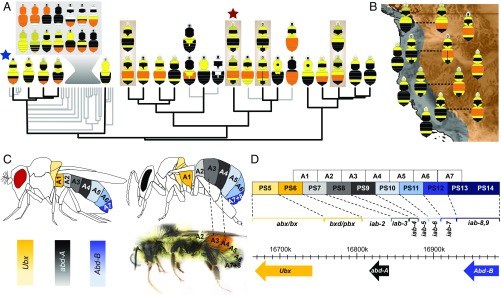Fig. 1.
An evolutionary framework for color pattern evolution in bumble bees. (A) Phylogeny of one subgroup of bumble bees, Pyrobombus (phylogenetic relationships data from ref. 31; 19% of all bumble bee species), that contains the study taxon B. melanopygus (red star), with the primary color patterns for those clades mapped. This emphasizes the diversity and modularity of coloration, the most common and ancestral bumble bee pattern (blue star), and four comimetic species that change their color in parallel (brown boxes). Gray box, Primary patterns from the indicated clade; gray branches, non-North American taxa. (B) Map conveying mimetic patterns of western North America showing species in each mimicry zone from A, with polymorphic species indicated with dotted lines. Additional species outside of Pyrobombus also mimic these patterns. (C) Spatial distribution of the BX-C Hox genes in D. melanogaster (Left), expected expression for male bumble bees (Right) applying the Drosophila model, and its translation to B. melanopygus. The color polymorphism in B. melanopygus takes place at A3 (metasomal T2) and A4 (metasomal T3), corresponding to segments controlled by abd-A. Color intensity in diagrams reflects relative amount of expression of the dominant gene. (D) Protein coding sequences of BX-C Hox genes (bottom) and infraabdominal (iab) expression domains (bracketed) in Drosophila melanogaster. BX-C gene expression is controlled by colinear regulatory domains, with each parasegment (PS) controlled by a different iab region (bracketed). Boxes are colored by the gene and corresponding segments of the adult fly that they regulate (C). Figure drawn from data in ref. 40.

